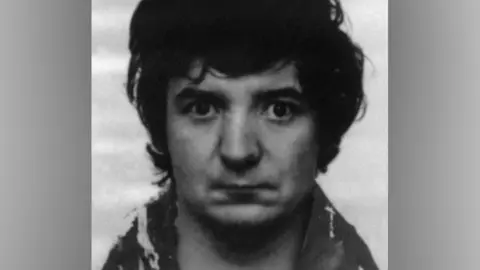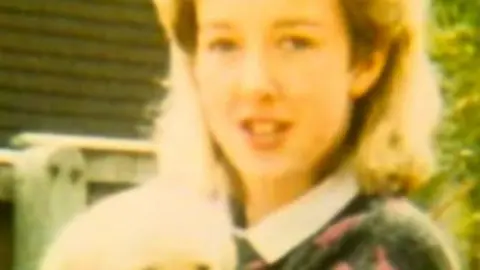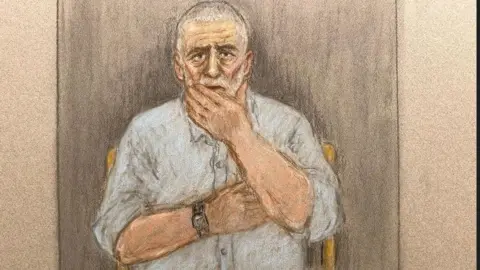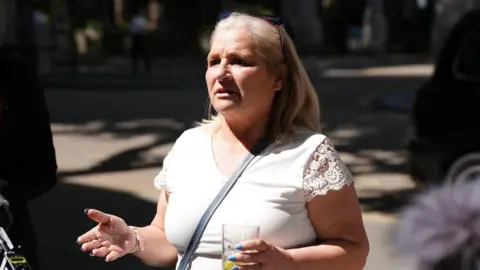Man jailed for 1986 murder acquitted after 38 years
 Merseyside Police
Merseyside PoliceA man who has served almost 38 years in prison for the murder of a woman has had his conviction quashed by the Court of Appeal after new DNA evidence emerged.
Peter Sullivan was jailed over the 1986 killing of 21-year-old barmaid Diane Sindall, who was subjected to a frenzied sexual attack in Birkenhead, Merseyside, as she walked home from a shift.
The Criminal Cases Review Commission (CCRC) - the statutory body set up to investigate potential miscarriages of justice - had referred Mr Sullivan's case back to the appeal court last year after fresh testing found a DNA profile pointing to an unknown attacker in semen samples preserved from the crime scene.
Mr Sullivan, appearing on video-link from HMP Wakefield, sobbed and held his hand over his mouth as he was told he would be released.
Now aged 68, he is believed to be the victim of the longest miscarriage of justice involving a living prisoner in British legal history.
In a statement read by his solicitor, Mr Sullivan said he was "not angry, I'm not bitter".
The statement read: "What happened to me was very wrong but does not detract that what happened was a heinous and most terrible loss of life.
"The truth shall set you free."
Speaking after the hearing, Mr Sullivan's sister Kim Smith said "no-one had won" and expressed sympathy for Miss Sindall's family.
"They've lost their daughter, they are not going to get her back. We've got Peter back, and now we've got to try and build a life around him again," she said.
"It's such a shame this has had to happen in the first place."
 Handout
HandoutBoth Merseyside Police and the Crown Prosecution Service (CPS) said the technology to test the semen samples did not exist at the time of the murder.
Duncan Atkinson KC, representing the CPS, had said the service agreed the DNA evidence undermined Mr Sullivan's conviction and there would be no application to seek a retrial.
Lord Justice Holroyde, sitting with Mr Justice Goss and Mr Justice Bryan at the Royal Courts of Justice in London, quashed the conviction and said they had "no doubt that it is both necessary and expedient in the interests of justice" to admit the new DNA evidence.
He said: "In the light of that evidence, it is impossible to regard the appellant's conviction as safe."
 Julia Quenzler/BBC
Julia Quenzler/BBCLord Holroyde said injuries to the victim "plainly did point to a sexual aspect of the attack on Miss Sindall" and the "inference was very strong" that the semen had been left by the real killer.
He continued: "There is no evidence to suggest more than one man was involved in the murder, and no evidence to suggest semen may have deposited in the process of consensual sexual activity."
The BBC understands Mr Sullivan left HMP Wakefield in a prison van shortly after 14:15 BST.
His release came 38 years, seven months and 21 days after his arrest, a total of 14,113 days in custody.
About a year of that time was spent in custody on remand as he awaited trial at Liverpool Crown Court.
The court heard technology had only very recently been developed to the point where the semen sample, recovered from Miss Sindall's abdomen, could be tested for DNA.
 PA Media
PA MediaThe DNA profile was not a match for Miss Sindall's fiancé at the time, the court heard, while cross-contamination from the forensic investigator who collected the semen samples had been ruled out.
Merseyside Police has since re-opened its investigation into Miss Sindall's murder but the force said "unfortunately" searches of the national DNA database had not come up with any matches.
The force said it "did not underestimate" the impact of the conviction on Mr Sullivan.
Det Ch Supt Karen Jaundrill said more than 260 men have been screened and eliminated from the renewed investigation since 2023.
"We have enlisted specialist skills and expertise from the National Crime Agency, and with their support we are proactively trying to identify the person the DNA profile belongs to, and extensive and painstaking inquiries are underway," she said.
"We can confirm that the DNA does not belong to any member of Diane's family, nor Diane's fiancé at the time, and we believe it could be a vital piece of evidence linking the killer to the scene."
 PA Media
PA MediaNick Price, director of legal services at the CPS, said: "We recognise the enormous impact this conviction has had on Peter Sullivan's life and the profound implications of the Court's decision in respect of this conviction.
"The prosecution case was brought on the basis of all the evidence available to us at the time."
He said after the new DNA evidence was presented to the service it concluded it "could not oppose" the appeal.
Miss Sindall, who worked as a florist but was also doing part-time bar work to save up for her wedding, was believed to have run out of petrol while driving home from her shift at the Wellington pub in Bebington, Wirral, shortly after midnight on 2 August 1986.
Detectives believed she was walking to an all-night garage or a bus-stop on Borough Road in Birkenhead when she was attacked and dragged into an alley.
She suffered repeated blows to the head which caused her death, and also had injuries including bite marks and lacerations.
Bite-mark evidence
The day after her killing her clothes were found burning on Bidston Hill.
Mr Sullivan became a suspect after witnesses reported seeing a man who they recognised as "Pete" running out of some bushes near the site of the fire.
During the course of the investigation Mr Sullivan gave conflicting accounts of his whereabouts and offered "confessions", the court heard.
However, his defence said he had learning difficulties and was "highly suggestible".
He had also been interviewed without a solicitor or an appropriate adult.
At his original trial, the prosecution also relied on evidence matching bite marks on Miss Sindall's body to Mr Sullivan's dental impressions.
But the court heard forensic scientists now have expressed serious doubt as to the quality of bite-mark evidence.
Mr Sullivan first applied for his case to be reviewed by the CCRC in 2008, but at the time it concluded there was little chance any new DNA profile would be recoverable.
He also applied directly to the court for permission to appeal in 2019 but that too was rejected.
Another application to the CCRC was lodged in 2021. This time the body concluded that thanks to technological advances it was worth testing the semen samples preserved from 1986.
Mr Sullivan's defence team, led in court by Jason Pitter KC, said he acknowledged that attempting to test the sample any earlier could have destroyed it permanently without yielding any results.

Get our flagship newsletter with all the headlines you need to start the day. Sign up here.
